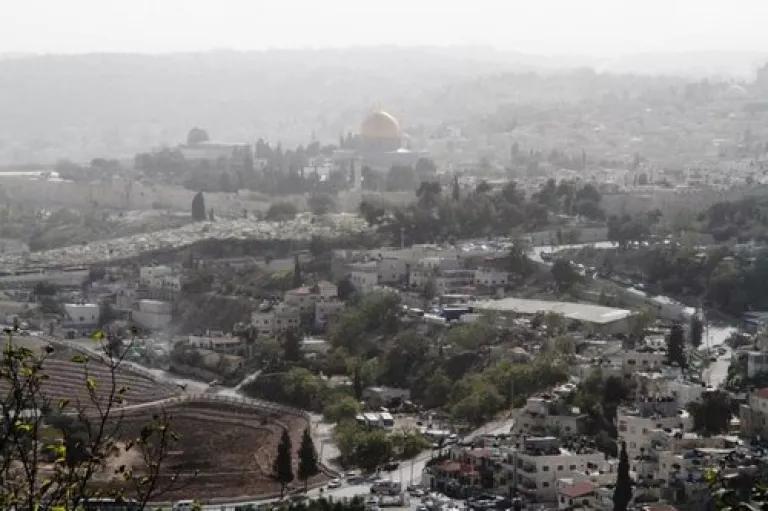
A Jewish guy and a Chinese guy are sitting on a park bench, talking. After a while, the Chinese guy says “You know, we have a 4,000 year old civilization.” The Jewish guy replies “Yes, I know; and we have a 5,000 year old civilization.” The Chinese guy pauses for a moment and then asks: “So tell me – for the first 1,000 years, where did your people go for takeout?”
[Rimshot]
But seriously. I recently went to Israel for two weeks, was home for a day, then flew to Beijing, China for a week. The Israel trip was a vacation, a history/archeology tour and an opportunity to hang out with my daughter who is in the Tikkun Olam Israel project in Jaffa (which the locals call “Yafo”). I was paying much more attention to the humus than to the local air quality issues until our tour stopped in the ancient city of Caesarea to see the Roman ruins. There, standing in what used to be the site of chariot races, I could see the exhaust stacks from a coastal fossil-fueled powerplant:
The leader of our tour told me that most of Israel’s electric power comes from coal and natural gas, all imported. This seemed odd to me given the huge potential for solar energy in the Negev Desert and Israel’s history of innovation in water recycling. Our first view of Jerusalem, coming in from the desert, was very hazy:

The locals blame this on sand blowing in from the desert. However, a recent government report suggests that this is not true, and that the sources of pollution in Israeli cities are what you would expect: vehicles, energy production, industry.
Israel may have had a 1,000 year head start on air pollution according to the old joke, but Beijing has more than caught up. I grew up in Los Angeles in the 50s and early 60s when smog alerts were common, but I have never experienced air pollution as bad as what I saw and breathed in Beijing. The air was sour, heavy, dank and the smog/haze cut visibility at times to less than a mile. Plus, the city is jammed with cars and cigarette smoking is common. Santa Monica, it ain’t.
NRDC’s Beijing office has been working to improve air quality and energy efficiency in China. I was invited to give a talk to a conference with the Beijing-based Center For Legal Assistance To Pollution Victims (CLAPV) that NRDC co-hosts every year. My topic was citizen lawsuits: the idea that people can bring lawsuits to help enforce environmental laws or on behalf of an endangered species or threatened habitat, for example. This was not a familiar concept to the audience of lawyers, judges and law professors and the questions after my talk were lively, including this one: “Do fish have standing to sue?” There are interesting environmental “public interest litigation” mechanisms under discussion in China, including the idea of giving environmental agencies or environmental groups the standing to bring civil enforcement actions in court. These could provide much needed support to still-uneven environmental enforcement efforts in China, and we are helping China to develop these ideas.
Here in the U.S., we have given China and Israel a millennia-long head start but are competitors for bad air quality. My next trip may be to Newark, N.J. to talk about solutions to port pollution there (by the way, I saw a Maersk shipping container next to the Sea of Galilee!). My hope is that we can work out solutions to ozone (smog), diesel and other air pollution that can be emulated around the world.
